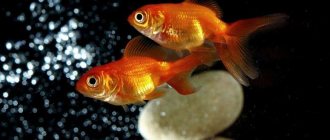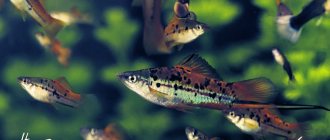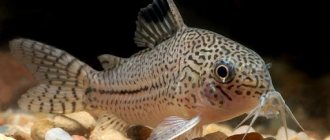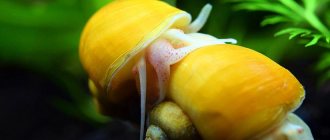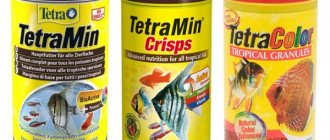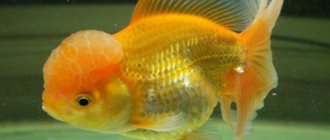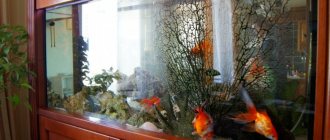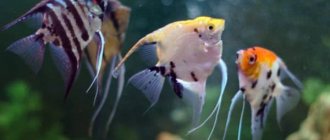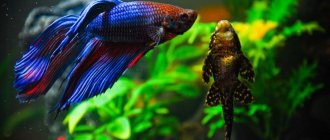If you want to not only admire the fish in the aquarium, but also regularly increase their number, we recommend that you familiarize yourself with the breeding conditions of these aquatic pets.
Breeding fish in a home aquarium is perhaps one of the most difficult aspects of aquarium farming. Here, desire alone is not enough; special knowledge and certain experience are required. This article will try to reveal the features of breeding aquarium fish at home.
- Immersion of eggs in the ground
- Feeding the fry
- Overpopulation
How do fish reproduce?
There are monogamous and polygamous, responsible parents and caviar-eating pets.
Sexual method
Sexual reproduction predominates in aquarium fish. Methods for fertilizing eggs:
- Interior. Insemination occurs in the body. Characteristic for viviparous women.
- Outer. The eggs are fertilized in the pond. Refers to spawn-laying.
Depending on the development of eggs, there are three types:
- Viviparous. Development and gestation occurs inside the mother. The embryos feed directly from the mother's body. Breeding is easy due to the high survival rate of the offspring.
- Ovoviviparous. The fertilized eggs are attached to the posterior part of the oviduct. Difference from viviparity - the offspring are separated from the mother's metabolism, nutrition occurs from the contents of the yolk. The mother's body serves only to protect against external threats.
- Egg-laying (oviparous). Deposition of eggs in water.
Parthenogenesis
Parthenogenesis means the development of eggs without fertilization by a male. Rarely found in aquarium conditions. From the eggs, male and female individuals emerge, which over time regulates the numerical ratio of the sexes. This type of reproduction occurs in cyprinids, as well as commercial fish. Unfertilized eggs are adjacent to fertilized ones. Viable offspring rarely appear. Parthenogenesis is a sexual method of reproduction, since germ cells are involved, but gamete fusion does not occur.
Gynogenesis
Males and females of different species participate. As with parthenogenesis, the eggs are not fertilized. The male activates the spawning process. Offspring are born only female.
Hermaphroditism
The presence of male and female characteristics, manifested sequentially or simultaneously. Hermaphroditism includes changing sex during life or laying eggs and fertilization by one fish.
Daylight hours and aquarium orderlies
I don’t turn off the light for the fry in the first two weeks. I believe that it is on these days that the fry especially need food and they should be fed around the clock. As orderlies, as soon as the fry swim, I add several ampullary snails to them. Ampoules clean the bottom of the aquarium from dead eggs and food residues.
And just recently, while breeding pink danios, I discovered another useful orderly and this is the Ancistrus fish. I added a small ancistrus to the fry as soon as they swam.
The peaceful ancistrus did not pay any attention to the tiny fry, but calmly continued to scrape the bottom and walls of the aquarium.
Types of fish
Viviparous
The fish are unpretentious and hardy, and can be easily bred by aquarists. To start spawning, there is no need for frequent water changes and changes in diet - the reproduction process begins by itself. The offspring are completely independent. Viviparous animals lack parental instincts. This group included:
- guppy;
- swordtails;
- mollies;
- platies;
- Gambusia;
- four-eyed fish;
- Formosa.
Spawn-marking
Females lay eggs, and males fertilize them. Fish have learned to hide their offspring from others under plant leaves, in rocks and caves, and in shells.
Eighth rule - water quality
Whatever fish you purchase, any of them is very sensitive to the chemical composition of the water. And filling the aquarium should begin by checking the composition of the water. All water composition parameters can be checked using special tests for aquarium water. To do this you need to purchase such a test.
Then collect the required amount of water into a clean, well-dried test tube, glass, or glass. Add an indicator reagent to the water and shake the test tube with water. After 5 minutes, compare the result obtained in the reference map. Based on the results obtained, action must be taken. If the water turns out to be very hard, then it needs to be softened.
Onset of puberty
Development happens:
- direct;
- indirect.
Direct is characterized by a similar structure of fry and adult fish. Indirect development occurs with transformations: the born individual does not resemble its parents. Those that lay eggs are characterized by an indirect type of development.
To have a similar structure to adult individuals, the offspring go through several stages:
- An embryo is formed inside the egg.
- After passing through the embryonic stage of development, the future fry enters the larval stage. It begins with a rupture of the egg membrane. The larva has large eyes and an elongated body without fins. In the first few days the larva is motionless.
- The whitebait visually resembles a smaller copy of an adult fish. Scales and fins appear.
- Gradually the fry grows to adulthood.
Viviparous species produce independent and structurally similar offspring - fry. This is a direct development.
Fish with a short life cycle become ready to reproduce earlier. Already at the age of 2 months, the fish is ready to reproduce. In small cichlids - at 3 months. Large fish with a long lifespan develop by 4-5 years. There are species that mature in 15-30 years. Males reach puberty earlier than females.
Care of offspring
Born fry, as a rule, are left in the tank where they were born. If the fry were hatched in a common aquarium, they are transplanted into a separate container. Young animals need to be fed 4 times a day. Special mixtures for fry, ground dried daphnia and Artemia nauplii are used as feed. The food is evenly distributed over the surface of the water so that it is easy for the fish to reach it.
When raising fry, special attention should be paid to water quality. The filter is used with caution, as juveniles can easily get inside it and die. Cleanliness is maintained by cleaning the bottom with a siphon and changing water. Good aeration is important. As the juveniles grow, they are transferred to a larger tank and, if necessary, sorted by sex and size. It is important to avoid overcrowding and keeping large fish with small ones to avoid cannibalism.
Reproduction of viviparous
Livebearers spawn several times a year without creating special conditions. If spawning does not occur, gradually increase the temperature a couple of degrees. Pregnancy proceeds faster at elevated temperatures, but too warm water will result in non-viable offspring.
During the incubation period, the female's abdomen will grow and become noticeably rounder, and when it becomes more square, place the expectant mother for a quiet birth.
Keep the offspring separate from the adults, otherwise the fry will be eaten.
Prepare a separate aquarium or a special trap for breeding aquarium fish. After two weeks, the first sexual signs appear. Sort the fry by sex: individuals with a dark spot on the abdomen are females.
Aquarium - where to start breeding fish at home
Breeding fish in an aquarium is a hobby for millions of people. Both adults and children enjoy watching living creatures of unique beauty splashing in the water.
Do you love nature and animals, but don't know which pet is right for you? Get an aquarium. Caring for fish is simple and does not require much time. And watching the movement of a colorful flock will bring many interesting and pleasant minutes. The question that a beginner asks himself when he decides to start an aquarium is where to start? The first step is to familiarize yourself with the general recommendations to decide whether this hobby is right for you.
- What a beginner aquarist needs
- Launching an aquarium: secrets of mastery
- What kind of fish should a beginner get?
- How to care for an aquarium
What a beginner aquarist needs
When buying an aquarium you need to be responsible. If you simply fill it with tap water and add tenants purchased on the same day, you will be greatly disappointed. The water will become cloudy and the fish will most likely die.
An aquarium is a fragile ecosystem. The most important task is to establish balance in it. When the water is clear, the plants are lush and green, and the fish are happy. It is best to start getting acquainted with aquariums by reading literature and communicating on forums of like-minded people. And when you feel that the issue has been sufficiently studied, feel free to go to the pet store.
Aquarium diagram
Pet stores have everything a beginner needs for an aquarium. At the first stage you need to buy:
- Aquarium . Many people think that it is better to buy the smallest one to start with. But this is not true; it is more difficult to establish balance in a small container. Therefore, choose a fish house with a volume of at least 40-50 liters, and preferably more. Stop at the simplest rectangular aquarium - it is easier to care for than a round or shaped one.
- Lighting . Both fish and plants require additional light, especially if the aquarium is located in the back of the room. Usually the lid sold with the aquarium already contains the required minimum of lamps. The best ones are fluorescent lamps and ordinary energy-saving lamps. For a volume of 50 liters, lighting of 25-30 watts is sufficient.
- Filter . In order for the water in your aqua world to remain clean and clear, it must be purified. So your next purchase will be a filter. They are internal and external. For a beginner, it is better to purchase an internal filter. Almost all filters have an aeration system - air from the room is supplied to the water and sprayed there with small bubbles so that the fish have something to breathe.
- Heater and thermometer . Most aquarium fish are thermophilic. To keep your residents from freezing, you need to maintain a temperature in the aquarium of about 22-23 degrees.
- Soil . If you want to admire not only fish, but also lush thickets of aquatic plants, you need to take care of suitable soil. Do not buy a color mixture; poor quality paint can be toxic. The best soil is quartz, basalt, granite with a grain diameter of 2-4 mm. Smaller ones often cake and sour, and in larger ones it will be difficult for plants to take root. Read more about the soil here.
- Net, feeder, siphon . No aquarist can do without these little things.
Decorative elements
Launching an aquarium: secrets of mastery
So, all the equipment has been purchased and is waiting in the wings. The question arises: what about the fish? When will their turn come? There is no need to rush with the fish. Their turn will come only in two to three weeks. In the meantime, we need to start starting the aquarium. Launching is a process during which the balance necessary for the life of fish is established in a container filled with water.
You need to act strictly according to plan:
- Preparing the soil and container. The aquarium needs to be thoroughly washed and rinsed. The soil should also be rinsed several times to remove dust and very small particles. Stones and driftwood to decorate the composition are also washed.
- Creating an underwater landscape. The aquarium is put in place and they begin to conjure to create a beautiful landscape. First, fill the soil with a layer of 4-5 cm, making a slight slope towards the front wall. Then they install decorative elements - pebbles, driftwood, grottoes. Fill in a third of the volume of water.
- Planting an underwater garden. Now it's the turn of the plants. For beginners, unpretentious species are suitable - vallisneria, hornwort, rotala, cryptocorynes, elodea. When planting, proceed as with ordinary land plants. The long roots are lightly trimmed, the bush is buried in the soil and the hole is sprinkled. At first, you can weigh down the bushes with pebbles so that they do not float up.
- Filling water and installing equipment. The work is nearing completion. Water is poured into the aquarium, and then a filter, a heating pad and a thermometer are attached to the glass. The equipment is turned on immediately.
- Balance. Now you need to forget about the aquarium for a while. Yes, yes, you don’t have to worry that the water has become cloudy and the overall composition looks unpresentable. After a week, the water will gradually clear, the plants will straighten their leaves. This will mean that balance is being established in your underwater world. But even now there is no need to rush with the fish. If you really want to, you can throw snails in there and wait another week.
What kind of fish should a beginner get?
In the pet store, your eyes widen from the abundance of fish - big and small, bright and not so bright, nimble and calm. How not to get confused among this splendor and choose those pets that will please the eye and will not require complex care?
It is best to introduce the most unpretentious fish into an aquarium for beginners. Here is an incomplete list of aquarium residents that are undemanding to living conditions:
- Guppy . The most popular fish. Bright males and gray females live in almost any conditions. And with proper care, they will also delight you with offspring.
- Swordtails, platies, mollies . Viviparous fish of bright colors - red, black, yellow.
- Gourami . Beautiful, unpretentious fish with lower fins in the form of long mustaches.
- Barbs . Striped, very active pets. It is better to keep them separately, because many individuals are pugnacious and offend more peaceful fish.
- Catfish . Be sure to get yourself some Corydoras or Ancitrus. It's very interesting to watch them.
- Danio . A cheerful flock of these minke whales will decorate any aquarium.
How to care for an aquarium
Finally, your aquarium is populated with residents. It is not difficult to care for it; it is enough to spend a couple of minutes every day and half an hour to an hour once a week.
The fish are fed daily. If you do this every time at a certain time, they will soon get used to the regime and will swim to the feeder in anticipation of a meal. There is a lot of ready-made dry food in stores, but it is still better if you can feed the fish with live food - daphnia, bloodworms, tubifex. You can buy live food at bird markets or arm yourself with a net, walk along nearby bodies of water and get the food yourself.
On weekends, it’s time for more thorough care of the aquarium. You will have to replace some of the water, remove debris from the bottom, rinse the filter, and clean the glass. Water for replacement must first be settled. Approximately 15-20% of the total volume is changed. For example, if your aquarium holds 50 liters, then replace 7-10 liters of water.
Aquariums often become a lifelong hobby, because creating underwater worlds brings peace and tranquility to a busy life. This hobby is much more interesting and useful than fishing.
Author: Kirichek Oksana, especially for the online magazine Women's Hobbies.
Reproduction of spawners
Spawners spawn in different ways. Some species form pairs, others form harems or flocks. The spawning tank is prepared in accordance with the characteristics of the producers.
Dispersal of eggs
Dispersal occurs during school spawning. The eggs scatter randomly and fall onto the ground, leaves and stones. Adult fish do not show parental affection and eat the eggs. To protect the eggs, place the soil in the form of balls with a diameter of 1 cm, cover the bottom with a mesh with small cells.
Masonry formation
The pair form a clutch in a secluded place. The eggs are carefully cared for and protected. Place shelters and broad-leaved plants in the spawning aquarium, where it will be convenient to spawn.
Formation of masonry in caves and gorges
This behavior is typical for fish emerging from aggressive habitat conditions. The spawning ground is equipped with shelters made from piles of rocks, large shells and pots.
Immersion of eggs in the ground
Killie fish, coming from shallow reservoirs with muddy bottoms, form temporary pairs. Pay attention to the soil, choose a substrate based on peat or coconut fibers. Once the parents have spawned the eggs, they can be stored for a couple of months in a warm, dry place. This feature is used when sending eggs by mail.
Nest of bubbles
Labyrinthine fish build nests from air bubbles and pieces of plants. Parents form pairs for life and carefully care for the eggs until the fry appear. When decorating a spawning container, place tall and floating plants. It is imperative to have a tight lid in which an air gap is formed.
Peculiarities of reproduction of popular fish
Fish reproduction is accompanied by interesting features:
- Some fish care for their offspring during the egg stage. Then their parental instincts fade away.
- Male cichlids, on the contrary, are overly worried about the offspring and show aggression towards females if they don’t like something in the treatment of the offspring.
- A sharp change in conditions in viviparous fish leads to a change in sex from female to male.
- Discus fish, angelfish and fairy cichlids take a long time to choose a partner for mating and form a pair for life.
Overpopulation
Overpopulation is an excess of fry per container. The larger the fry become, the more space they require. If there is not enough space in the tank for the fry, they develop poorly, and some representatives die. In an overcrowded tank, harmful microorganisms and bacteria accumulate, which lead to diseases in the offspring. As the fry grow, they need to be moved to a larger tank so that there is enough space for everyone.
Problems
- Breed aquarium fish responsibly. Create conditions for future fish in advance. Calculate how much aquarium volume you will need. Often, due to incorrect calculations or too many offspring, fish suffer from overpopulation. When there is not enough space, the fish become aggressive towards each other and experience stress. In an overcrowded tank, the fish grow smaller in size, which leads to subsequent health problems.
- Another problem is that the fry do not survive to the teenage stage. The death of fry is caused by improper selection of food and poor water quality. Remember that there should be no large particles of food in the container with the fry.
- Avoid inbreeding. Population degeneration occurs due to heterosexual offspring not separated in time. The fish look less bright and may have problems with further self-reproduction. The same applies to closely related species (swordtails, mollies, platies).
- If the necessary conditions are created, and the fish do not reproduce or lay infertile eggs, choose another male as the breeder. Most likely, his gonopodium is damaged or he is already old. The lack of offspring is also associated with unsuitable water parameters. If a white coating appears on the eggs, check whether the temperature is suitable for the fish and whether the water is too hard or soft.
My method of feeding fry
Aquarists' methods of breeding fish and feeding fry may vary, but in all cases the principle of alternating food is similar. For example, I give boiled yolk to the fry that have just swam for the place of the infusoria and immediately release live daphnia. I don’t wash the yolk of the smallest particles (milk), they are eaten by daphnia, and the water in the aquarium remains constantly clear. You can learn how to properly feed fry with yolk from my publication “How to feed fry with yolk.”
For the first 2-3 days, the fry feed on yolk and then switch to daphnia. Fry on live daphnia grow very quickly and do not lag behind in growth at all. The fry willingly eat boiled yolk: barbs, zebrafish, thornets, gourami, goldfish, and this list is far from complete.
Fry that do not eat the yolk should be fed with ciliates and also with a subsequent transition to live daphnia. From the first day of their birth, fry of viviparous fish can be fed with daphnia or vinegar nematode, on which they also grow well. You can find out how to breed a nematode worm in my publication “Breeding a nematode at home.”
conclusions
Breed fish by learning the intricacies of spawning the desired species. Get down to business if you have free time and sufficient passion. Choose healthy and vibrant individuals as breeders. Remember that not all species breed in domestic waters. Neons, large catfish, discus and some cichlids are difficult to breed.
Previous
FishPrincess of Burundi - a fish with a developed hierarchy
Next
Fish 16 types of koi carp for aquarium
